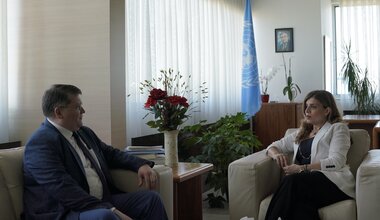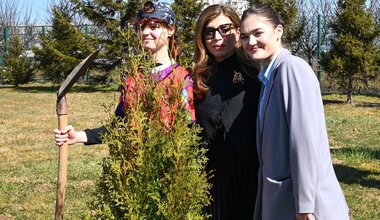22 Feb
2011
OSCE helps restore Orthodox cemeteries in Kosovo

Staro Gracko/Grackë e Vjetër, a village in Lipjan/Lipljan municipality in central Kosovo, is home to some 300 people, most of them Kosovo Serbs. The village has a cultural centre, a new school, a sports centre and a medical facility. Yet the village’s Orthodox cemetery was, until recently, a sore spot for many of the inhabitants. It had not been maintained since 2004, and was vandalized in 2005.
For many, the relations between different communities living in Kosovo are still tense. Lipjan/Lipljan municipality, with a majority Kosovo Albanian population, has not seen many serious security incidents, but villagers did not feel comfortable going out to the cemetery to clean it up. Following the March 2004 riots which led to brutal violence between Kosovo communities, many feared retribution and stayed put in their neighbourhoods.
Delayed repairs
“The municipality promised to fix the cemetery in 2005 but it didn’t happen,” says Lidija Jovanović, Municipal Co-ordinator for Returns and Communities. The reason given was a lack of funds, and the cemetery was left in neglect.
Staro Gracko/Grackë e Vjetër residents were not the only ones with such concerns. An assessment carried out by the OSCE Mission in Kosovo’s regional communities teams in summer 2010 concluded that the maintenance of Orthodox cemeteries throughout Kosovo was generally poor.
“Most graveyards did not have fences, there was lots of high grass and weeds, and in some cases garbage was dumped on the sites,” says Bekim Uka, of the OSCE communities team in Prishtinë/Priština. “Some graveyards had not been cleaned since 1999.”
Community action
To help the municipality keep its promise and attend to the residents’ request, the OSCE teamed up with the local community and municipal authorities and financed a project to clean up and fence the graveyard.
On top of improving the condition of the Orthodox cemetery, the project also aimed to improve relations between the village residents and the municipality and to encourage volunteerism among community members. “Kosovo Serb villagers helped the contractor with removing the old fence, and putting the new one up,” says Uka, “and were particularly active in helping clean the graveyard.”
Zoran Čirković, along with his friends, took the project a step further. “We came up with the idea to sell the old fence, and use the money to further improve the cemetery,” Čirković says. “And it was a great idea. We managed to fix 22 damaged head stones with that money, and when people come to see what we’d done, they were truly surprised,” he adds.
According to Uka, the project will also help municipal officials understand the relevance of cultural heritage sites, and their responsibility to clean and maintain other graveyards. “According to the law, this is a municipal responsibility,” he notes.
Positive results
Radmila Simjonović, Head of the Municipal Office for Communities and Returns in Lipjan/Lipjlane, says local residents now see that the municipality cares about community needs and is willing to take action. “It’s very important for them to be able to access the graveyard and light a candle with dignity,” she says.
The work in Staro Gracko/Grackë e Vjetër was completed in mid-January 2011, solving a five-year-old problem. The Mission has developed similar projects in other parts of Kosovo. In Fushë Kosovë/Kosovo Polje municipality a new fence has been put around a two-hectare Orthodox cemetery, and in Prizren and Pejë/Peć work on graveyards is ongoing.
The restoration work however, does not stop there. Zoran Čirković from Staro Gracko/Grackë e Vjetër wants to see the chapel rebuilt in spring, while in Fushë Kosovë/Kosovo Polje, the municipality plans to clean up the fenced graveyard once the weather gets better, then move on to other villages which need similar work. The Mission will continue to monitor the process of restoration throughout the year.
 UN
UN United Nations Peacekeeping
United Nations Peacekeeping





